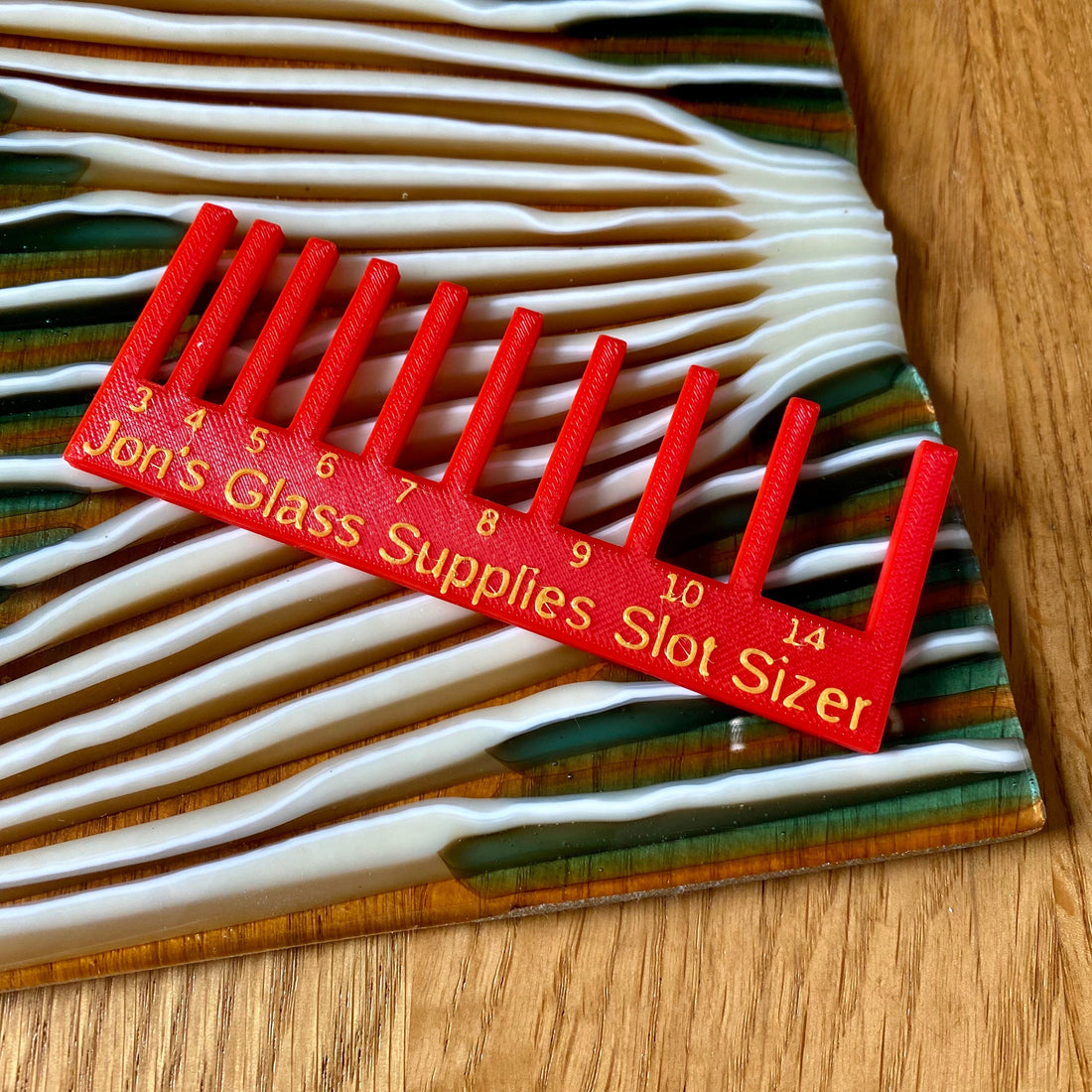
Glass Display Stands: Finding the perfect fit
Share
As a fellow glass maker I know how hard it can be to find the stands that effortlessly showcase your glass at an affordable price.
Did you know that your glass may not be the thickness that you think it is? This can make it hard to find a display solution with the perfect fit. We are taught that after a full fuse firing that 2 sheets of 3mm Bullseye glass will become 6mm thick. Unfortunately that is not always the case, let's look at why.
How do I find the perfect fit?
My Slot Sizer is a quick and easy way to measure the thickness of your glass.
The slot sizer is a comb with graduating gaps between the teeth (in 1mm increments). The number at the base of the gaps is the size of the slot in millimetres (mm).
Push the glass into each slot, starting from the larger end.

See my video tutorial below for more details.
The Slot Sizer is Available in my store (Free), just pay postage.
What affects the thickness of my glass?
Here are the most common factors that can affect the thickness of your glass
Construction
- Number of layers / glass thickness: This is one of main factors that determines the thickness of your glass. The thicker the pile of glass, the harder it will have to work in the kiln to reach a uniform thickness of 6mm (see firing for more details). Consider how much accessory glass you have added to your artwork.
Tip: For an even thickness you want to aim to reach a constant thickness of 6mm of glass. 2 x 3mm layers or 3 x 2mm etc.
-
Method: Are you using complete layers of glass? What construction method are you using?
- Top down: cut glass on the base layer and a solid sheet on top which can reduce surface imperfections however could trap air.
Tip: run the cuts to the edge of the glass, put a layer of fibre paper under your thin fire, and increase your bubble squeeze firing segment to help let the air escape.
- Bottom up: Solid base layer with cut pieces on the surface, which might lead to surface imperfections.
Firing
-
Temperature: the key things are the temperature you reach and how long you hold it for.
- Full Fuse: should create a glossy & unform effect on your glass where all elements become one single piece of glass.
Tip: With a thicker stack of glass you may need to slightly increase the top temperature and/or hold duration. Try starting with 5º C / 5 min increments.
- Tack / Contour Fuse: this will leave a lovely textured surface to your glass.
Tip: consider how you want to display your glass before firing. Try to make sure that you have 2 or 1 layers of glass without accessory glass in the areas where the stand will hold the glass.
- Position in the Kiln: The temperature in your kiln may not be uniform. Get to know your kiln, run some experiments and observe the effects it has on your glass. Glass near the edge of the kiln may be not reach the same temperature as the glass in the centre/near the thermostat.
Tip: You can also use a test firing kit to see if you kiln is over or under firing.
Viscosity
Consider the flow of your glass when it is fired. Glass from the same manufacturer has the same COE (expansion rate). This reduces the risk of your mixed glass sheet cracking. However, the different glasses may still absorb heat differently and so move differently;
- Opalescent may absorb heat better than transparent glasses
- Darker colours may also absorb heat better than lighter colours, hence why there is an increased risk of cracks forming with BE Dense white opal.
- Additional coatings such as iridescent may reduce the flow of the glass.
Edge profile
The edge profile of your glass will affect how it will sit in a stand. Full Fused glass will have a natural curve from the top side to the kiln shelf whereas tack fused glass will have more of a defined edge.
The less flat or more uneven the edge profile of the glass will impact stability in a stand therefore getting the perfect fit (slot size) is more important.
Cold working the edges of your glass will remove imperfections and increase stability in a stand, however is not critical.
My range of display stands work will with either edge profiles of glass.
Tutorial
Slot Sizer - Available in my store (Free)
Featured in my tutorial 'Finding the perfect glass display stand' on youtube.
